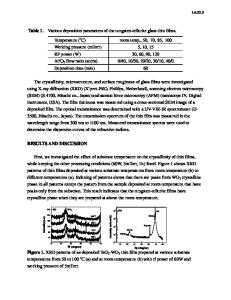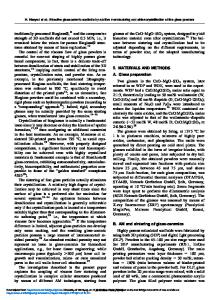Rapid and Quantitative Determination of Crystallization Tendency of Zinc Tellurite Glass Melt by Using Temperature-Gradi
- PDF / 147,533 Bytes
- 6 Pages / 612 x 792 pts (letter) Page_size
- 65 Downloads / 329 Views
Rapid and Quantitative Determination of Crystallization Tendency of Zinc Tellurite Glass Melt by Using Temperature-Gradient Furnace Shin-ichi Todoroki, Takehisa Matsumoto and Satoru Inoue Advanced Materials Laboratory, National Institute for Material Science, Namiki 1-1, Tsukuba, Ibaraki 305-0044, JAPAN ABSTRACT Quantitative thermal stability test of glass materials against crystallization is accelerated through a vertical temperature-gradient furnace. In the furnace, zinc tellurite glass melt is sucked into a 75cm-long glass capillary tube (ID 1.5 × OD 8 mmφ) and the tube is kept inside to be annealed under a temperature gradient of 300∼800◦ C/50cm. The time to precipitate is determined to make a set of T-T-T (Time-Temperature-Transform) diagrams for different composition and thermal hysteresis. Crystallization is not observed for 65TeO2 -35ZnO and 70TeO2 -30ZnO (mol%) super-cooled glass melt after 4000s annealing but their stability decreased if the melts were once quenched to below their glass transition temperature before the annealing. INTRODUCTION Precipitation during hot works is fatal for glass products, especially optical devices because it causes light scattering and fracture. Although several methods are known to evaluate thermal stability of glass materials, none can satisfy with the demand for both convenience and quantitativity. The most quantitative one is to determine critical cooling rate Q through making T-T-T (TimeTemperature-Transform) diagram[1], but tremendous amount of experiment (sample preparation, annealing with different temperature and time, and examining precipitation) is needed to make a single diagram. The most convenient one is to determine the gap between the crystallization temperature (Tx ) and the glass transition temperature (Tg ) observed in DTA (Differential Thermal Analysis) curve, but the gap is not directly related with Q. The intermediate one is to observe a set of glass samples annealed in a temperature gradient furnace, which still needs to prepare many samples. In order to shorten the time required for these stability tests, we proposed to use a vertical temperature-gradient furnace as a sample preparator and a parallel-annealing furnace(see Fig. 1(a)), and demonstrated a rapid compilation of T-T-T diagrams[2]. In this study, compositional dependence of Q and the effect of thermal history for zinc tellurite glass system is examined in order to demonstrate the usefulness of this method. Zinc tellurite glass system was chosen because of the following three reasons. First, it has the widest glass forming region among binary tellurite system. Second, low viscosity is available below the softening temperature of Pyrex glass cell. Lastly, various interesting optical properties are reported for tellurite glasses, such as non-linear optical effect, acousto-optics effect and broad band 1.55µm emission of Er3+ . EXPERIMENTAL DETAILS Zinc tellurite glass melt (xTeO2 –(100 − x)ZnO, x = 90 ∼ 65 mol%; hereinafter referred to as 75Te25Zn etc.) in a Pt crucible was mounted at the bottom
Data Loading...











